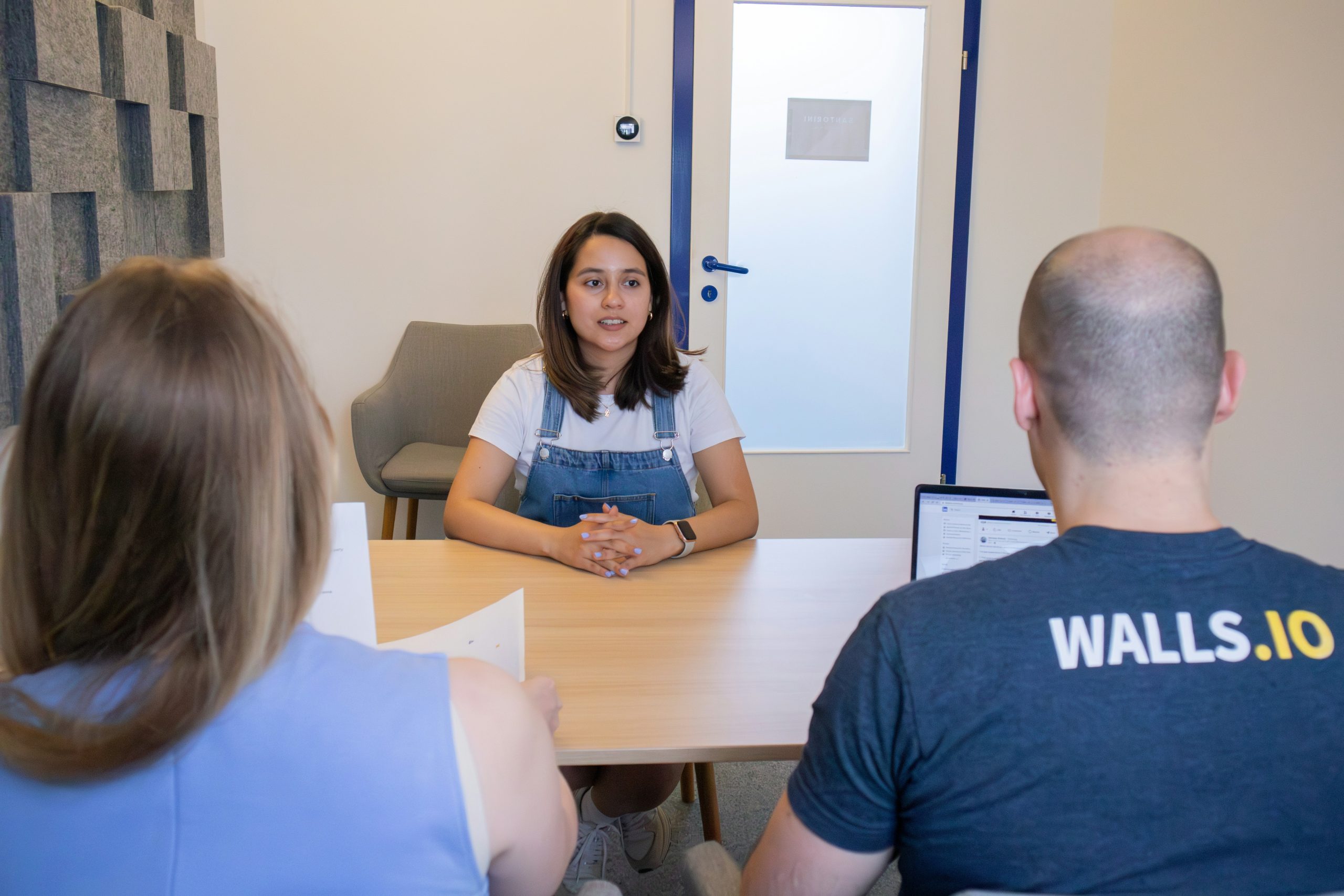
Subscribe for updates
Get talent acquisition best practices, trends, and news delivered directly to your inbox.
By entering your email, you agree to receive marketing emails from JobScore
The interview process is a delicate balance. You need to properly evaluate candidates to ensure a high quality of hire while navigating finite resources and providing a positive candidate experience. Experimenting with different interview techniques could help.
There’s more than one way to structure your interview process, and the ideal combination of techniques will be unique to your company and role.
This comprehensive guide will walk you through 13 different interview techniques, explaining how to conduct each one and weighing their advantages and disadvantages. By the end of this article, you’ll have a toolkit of strategies to help you make informed decisions and find qualified talent for your team.
1
Structured interviews
Structured interviews follow a predetermined set of questions asked in a specific order to all candidates. This method ensures consistency and fairness in the evaluation process.
Structured interviews are particularly valuable for employers that need to maintain consistency across their hiring process, especially when multiple team members are involved in recruitment. They provide a solid foundation for making data-driven hiring decisions and can help prevent common interviewing pitfalls.
How to conduct a structured interview
Advantages of structured interviews
Disadvantages of structured interviews
2
Unstructured interviews
Unstructured interviews are more casual and conversational, without a set list of questions. The interviewer adapts their questions based on the candidate’s responses and the natural flow of the conversation.
Unstructured interviews can be particularly effective when culture fit and adaptability are crucial factors in hiring decisions. They allow for a more authentic interaction between interviewer and candidate, which can be especially valuable when hiring for roles that require strong interpersonal skills or creative thinking.
While unstructured interviews shouldn’t be your only evaluation method, they can complement more formal assessment techniques. Consider using them as part of a multi-stage interview process, perhaps following a structured initial screening. This combination allows you to benefit from both the consistency of structured interviews and the insights gained from more organic conversations.
How to conduct an unstructured interview
Advantages of unstructured interviews
Disadvantages of unstructured interviews
3
Behavioral interviews
Behavioral interviews focus on past experiences and actions to predict future performance. The idea is that past behavior is the best indicator of future behavior.
Behavioral interviews are particularly valuable for employers looking to hire experienced candidates with a track record of success in past roles. They help identify candidates who have demonstrated the specific skills and competencies needed for success in your organization, rather than those who simply interview well.
How to conduct a behavioral interview
Advantages of behavioral interviews
Disadvantages of unstructured interviews
4
Situational interviews
Situational interviews present hypothetical scenarios to candidates and ask how they would handle them. This technique assesses a candidate’s problem-solving skills and decision-making abilities.
Situational interviews are a great way to assess how candidates might handle unique challenges specific to their organization, but work best when combined with other interview techniques. Consider using them as part of a comprehensive interview process that includes behavioral questions and skills assessments. This multi-faceted approach provides a more complete picture of a candidate’s potential performance.
How to conduct a situational interview
Advantages of situational interviews
Disadvantages of situational interviews
5
Skill assessments
Skill assessments are practical tests or exercises designed to evaluate a candidate’s specific abilities relevant to the job. They provide objective evidence of a candidate’s capabilities, which can be especially important when building specialized teams.
While skill assessments are a great way to evaluate technical skills, don’t rely on them exclusively. Combine them with behavioral and situational interviews to evaluate both technical proficiency and soft skills.
How to conduct a skill assessment
Advantages of skill assessments
Disadvantages of skill assessments
6
Topgrading
Topgrading is a comprehensive, chronological interview method that covers a candidate’s entire career history in depth. It can be especially valuable for employers making critical hires for senior positions or roles where past performance is a crucial indicator of future success.
How to conduct a topgrading interview
Advantages of topgrading
Disadvantages of topgrading
7
Sequential interviews
Sequential interviews, also known as serial interviews, involve a series of one-on-one interviews with different interviewers, typically conducted over the course of a single day or spread across multiple days. They provide a well-rounded view of the candidate and allow the candidate to get a deeper understanding of the company and role.
This approach can be combined with other techniques, such as having one interviewer conduct a behavioral interview while another focuses on technical skills. However, it’s important to balance thoroughness with efficiency to respect both the candidate’s time and your company’s resources.
How to conduct sequential interviews
Advantages of sequential interviews
Disadvantages of sequential interviews
8
Group interviews
Group interviews involve multiple candidates being interviewed simultaneously, often through group discussions or team exercises. They can be useful for employers that need to hire multiple positions simultaneously, want to assess team dynamics, or require strong collaboration skills.
While group interviews can be an efficient screening tool, they shouldn’t be your only evaluation method. Consider using them as an initial assessment followed by individual interviews with promising candidates. This combination allows you to observe both team dynamics and individual capabilities while maintaining a streamlined hiring process.
How to conduct a group interview
Advantages of group interviews
Disadvantages of group interviews
9
Panel interviews
Panel interviews involve multiple interviewers questioning a single candidate simultaneously.
They’re especially useful for organizations where new hires will need to work across multiple departments or teams. They help ensure buy-in from various stakeholders and provide a more comprehensive evaluation of each candidate.
How to conduct a panel interview
Advantages of panel interviews
Disadvantages of panel interviews
10
Phone interviews
Phone interviews are usually preliminary screening conversations conducted over the phone to assess basic qualifications and interest. They’re a great way to efficiently screen candidates with minimal cost.
How to conduct a phone interview
Advantages of phone interviews
Disadvantages of phone interviews
11
Video interviews
Video interviews use video conferencing technology to conduct face-to-face interviews remotely. They can help you expand your talent pool by making it easier for candidates to interview when they don’t live nearby or can’t take time away from work.
How to conduct a video interview
Advantages of video interviews
Disadvantages of video interviews
12
In-person interviews
In-person interviews are face-to-face meetings conducted at the company’s office or another physical location. They provide the most comprehensive opportunity to assess both professional qualifications and cultural fit while giving candidates a real sense of your work environment.
While in-person interviews often provide the most complete picture of a candidate, they require significant time and resources to conduct. Consider using them as the final stage in a multi-step process that begins with phone or video screenings. This approach helps ensure you’re investing face-to-face time with the most promising candidates while maintaining an efficient hiring process.
How to conduct an in-person interview
Advantages of in-person interviews
Disadvantages of in-person interviews
13
Lunch interviews
Lunch interviews are informal interviews conducted in a more relaxed setting, such as a café or restaurant. They’re particularly valuable for employers looking to build strong relationships with potential hires, especially for senior positions.
Lunch interviews can be a great technique to combine with an unstructured panel interview, giving candidates and your team members an opportunity to get to know each other.
How to conduct a lunch interview
Advantages of lunch interviews
Disadvantages of lunch interviews
Final thoughts on interview techniques
Having a wide range of interview techniques at your disposal can significantly improve your ability to identify top talent efficiently and effectively. Each method has its strengths and weaknesses, and the key is to choose the right combination of techniques that align with your company’s needs, culture, and the specific requirements of the position you’re filling.
Remember, the goal is not just to find someone who can do the job, but to find the right person who will thrive in your organization and contribute to its success. By mastering these interview techniques, you’ll be better equipped to make informed hiring decisions.



